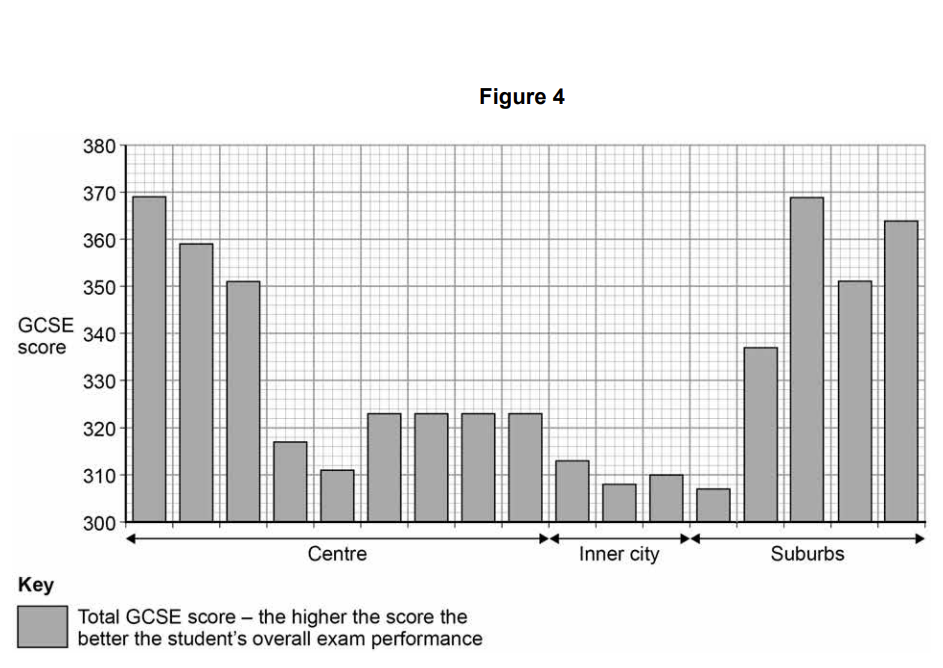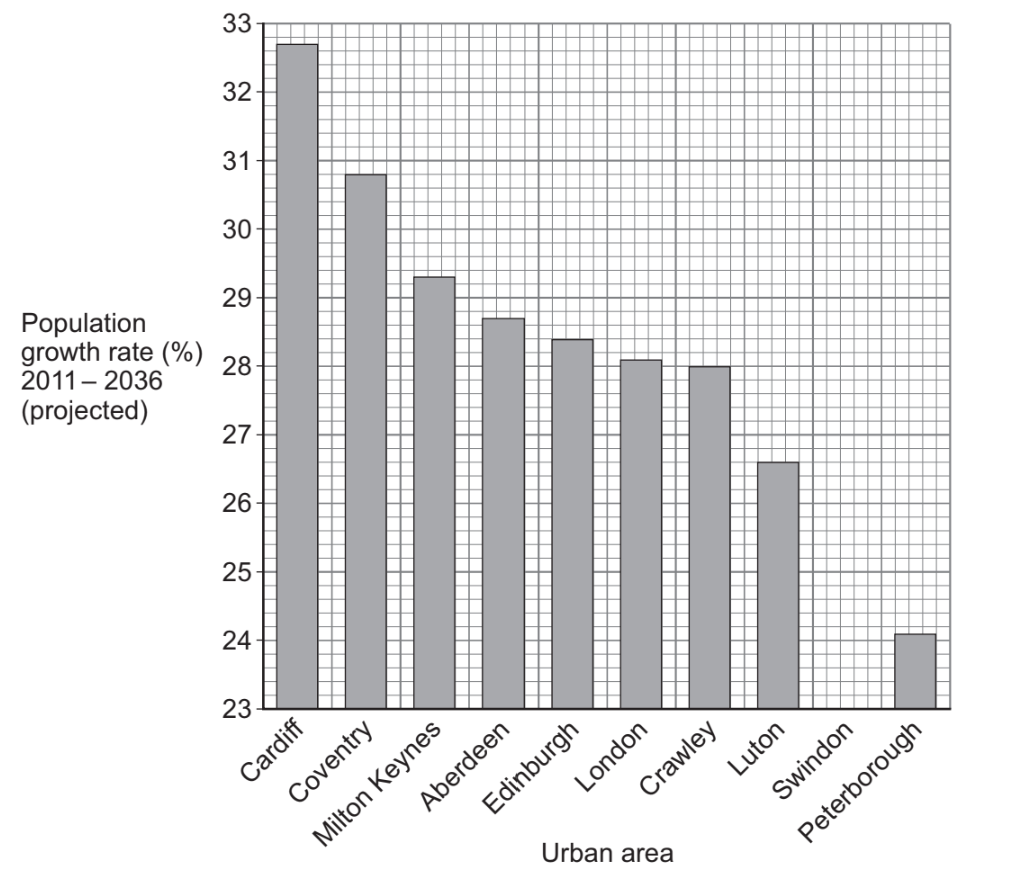Study Figure 3, some social media comments about traffic in Bangalore, a city in India.

Did this page help you?
Study Figure 3, some social media comments about traffic in Bangalore, a city in India.

Did this page help you?
Study Figure 4, a graph showing GCSE scores along a transect through a UK city.

Calculate the range in GCSE scores shown in Figure 4.
Did this page help you?
Study Figure 1, a graph showing the average annual urban growth rates for selected African countries, 1960–2010.

Use the following data to complete Figure 1.
| Country | Natural increase (%) | Migration (%) |
| Central African Republic | 2.4 | 1.1 |
Did this page help you?
Study Figure 3, a 1:25 000 Ordnance Survey map showing part of Liverpool, city in the UK.
Areas X and Y show two areas of urban regeneration.

0.1 km2
0.4 km2
0.7 km2
1.0 km2
Did this page help you?
Urban sprawl
Urbanisation
Migration
Urban regeneration
Study Figure 1, a graph showing the percentage of people living in urban areas in selected countries.

| Country | % living in urban areas in 2019 | % living in urban areas in 2050 (projected) |
| UK | 84 | 90 |
| China | 60 | 80 |
| India | 35 | 53 |
| Nigeria | 51 | 70 |
Did this page help you?
Study Figure 3, in the insert, a 1:50 000 Ordnance Survey map (Map extract key) showing part of Aberdeen, a city in the UK.

0686
0687
8606
8706
2.8 km
3.3 km
3.8 km
4.3 km
Did this page help you?
Study Figure 1, a graph showing the percentage of the population living in urban areas in different parts of the world 1950–2050 (projected).

Did this page help you?
Study Figure 2, a pie chart showing the reasons for rural–urban migration in a region box of Pakistan, a country in Asia.

Did this page help you?
500 000 people.
1 million people.
5 million people.
10 million people.
Study Figure 1, a map showing cities that are expected to become megacities by 2035.

Did this page help you?
Study Figure 3, a graph showing the percentage of household waste that was recycled in 2016-17 in selected cities in the UK.

| City | Percentage of household waste recycled |
| Hull | 50 |
Did this page help you?
Study Figure 5, a graph showing air pollution for 24 hours on 3 January 2019 in New Delhi, a city in India.

Did this page help you?
| Name of UK city | |
| Location in the UK | |
| Importance in the UK |
Did this page help you?
Urban issues and challenges
Study Figure 1, a world map showing the rate of growth for some major cities, measured in people per hour.
Figure 1

Calculate the mean rate of growth per hour for the Asian cities shown in Figure 1.
Answer to the nearest whole number
Show your working
Answer = ____________ people per hour
Did this page help you?
Give one way in which a major city in an LIC/NEE is regionally important.
Name of city
Regional importance
Did this page help you?
Study Figure 4, a graph showing the 10 UK urban areas with the highest population growth rate (%), 2011–2036 (projected).
Figure 4

Complete Figure 4 using the following data
| City | Population growth rate (%) 2011–2036 (projected) |
| Swindon | 26.5 |
Calculate the range of population growth rate (%), 2011–2036 (projected) for the urban areas shown in Figure 4.
Shade one circle only
8.0%
8.3%
8.6%
8.9%
Did this page help you?
Study Figure 5, a map showing the 10 highest and 10 lowest UK urban areas for population growth rate (%), 2011–2036 (projected).
Figure 5

Compare the distribution of the 10 highest and 10 lowest urban areas shown in Figure 5.
Did this page help you?
Assess the extent of the challenges created by urban growth in LICs/NEEs.
Use a case study of a city in an LIC/NEE.
Name of LIC/NEE city
Did this page help you?
Did this page help you?
Did this page help you?
Assess the challenges created by urban change in a UK city you have studied
Name of UK city
Did this page help you?
Study Figure 5a and Figure 5b which were taken at point X on Figure 4. They show the same location before and after a regeneration scheme.

Suggest how a regeneration project can solve urban problems. Use Figure 5a and Figure 5b and a UK example you have studied.
Did this page help you?

Did this page help you?
Using Figure 4 and your own understanding, suggest reason(s) for inequalities in education in urban areas in the UK.

Did this page help you?
Study Figure 4, showing some information about Area X and some photographs of Area Y in Figure 3 below.


Explain how regeneration can help to solve urban problems.
Use Figure 4 and your own understanding.
Did this page help you?
Study Figure 4, in the insert, a 1:50 000 Ordnance Survey map (Map extract key) from the 1950s showing the same area of Aberdeen as Figure 3.


Suggest how urban sprawl and the growth of commuter settlements have impacts on the rural-urban fringe.
Use Figure 3 and Figure 4 and your own understanding.
Did this page help you?
Study Figure 2, maps and information about the Kendal Industrial Park in Java, Indonesia.
Figure 2

Explain how urban industrial areas can help encourage development.
Use Figure 2 and your own understanding.
Did this page help you?
Study Figure 2, a photo of a shared toilet in an Indian city.

Suggest why sanitation systems in cities in LICs/NEEs create challenges.
Use Figure 2 and your own understanding.
Did this page help you?
Study Figure 2 photographs of the Vertical Forest development in Milan, a city in Italy.

Explain why creating green space is important for sustainable urban living.
Use Figure 2 and your own understanding.
Did this page help you?
Study Figure 2, a newspaper extract about urban change in sub-Saharan Africa.
Figure 2
| Housing in sub-Saharan Africa improves but millions still live in slums A new study of housing quality in sub-Saharan Africa states ‘there has been a dramatic improvement in living conditions during the past 15 years’. Researchers found housing had improved across several measures during the period. Amount of living space, access to water and sanitation, and good quality construction were found in 23% of houses in 2015, up from 11% in 2000. The study’s author said, “Our study shows that many people are investing in their homes, but there is also an urgent need for governments to help improve infrastructure.” |
Explain how urban planning is improving quality of life for the urban poor.
Use Figure 2 and an LIC/NEE example you have studied.
Did this page help you?
Study Figure 3, a photograph and factfile about transport improvements in Utrecht, a city in the Netherlands.
Figure 3

Suggest how developments such as this can help urban areas to become more sustainable.
Use Figure 3 and your own understanding.
Did this page help you?